Carrier (1999) (45 page)
Authors: Tom - Nf Clancy

The official emblem of Carrier Air Wing One (CVW-I)
JACK RYAN ENTERPRISES, LTD., BY LAURA DENINNO
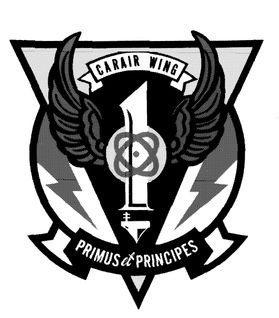
That the
GWʼ
s embarked air wing, CVW-1, is a powerful offensive tool is a surprisingly recent development. During the Cold War, the focus of American carriers and their air wings was not the projection of offensive power but the defense of the carrier groups and other naval forces (convoys, amphibious groups, etc.). In those days, air wing training and weapons were mainly oriented toward war-at-sea missions against the Navy of the former Soviet Union, not toward land targets requiring precision deliveries. This is one of the reasons why the performance of Navy aircraft and units during the 1991 Persian Gulf War was so disappointing. Though Navy aircraft flew almost a third of the attack sorties into Iraq, they lacked the PGMs and sensors necessary to kill precision targets. On the positive side, Navy reconnaissance and electronic-warfare aircraft did really useful work, as did the A-6E Intruder all-weather attack bombers (recall that the weather over Iraq was terrible during much of the air campaign). Incredibly, in the name of cost-saving, the entire fleet of A-6E bombers and KA-6D tankers was retired after the Gulf War!
GWʼ
s embarked air wing, CVW-1, is a powerful offensive tool is a surprisingly recent development. During the Cold War, the focus of American carriers and their air wings was not the projection of offensive power but the defense of the carrier groups and other naval forces (convoys, amphibious groups, etc.). In those days, air wing training and weapons were mainly oriented toward war-at-sea missions against the Navy of the former Soviet Union, not toward land targets requiring precision deliveries. This is one of the reasons why the performance of Navy aircraft and units during the 1991 Persian Gulf War was so disappointing. Though Navy aircraft flew almost a third of the attack sorties into Iraq, they lacked the PGMs and sensors necessary to kill precision targets. On the positive side, Navy reconnaissance and electronic-warfare aircraft did really useful work, as did the A-6E Intruder all-weather attack bombers (recall that the weather over Iraq was terrible during much of the air campaign). Incredibly, in the name of cost-saving, the entire fleet of A-6E bombers and KA-6D tankers was retired after the Gulf War!
So, after building their plans and policies around a now-dead threat, and buying and retaining the “wrong” aircraft and weapons for the turn-of-the-millennium world, naval aviation entered the post-Cold War era in disarray. Happily, naval aviators are resourceful people, and during the mid-1990’s Navy aviators gradually developed technical “quick fixes” and organizational reforms that will equip the Cold War CVW to tackle the challenges of the next decade. Understanding that it would take years and billions of dollars to develop and build new aircraft and weapons, they concentrated on upgrading existing airframes with new systems and weapons.
These focused on supporting the initiatives presented in high-level policy statements like “From the Sea” and “Forward from the Sea,” while grimly defending the huge funding allocation necessary for the next-generation “Super Hornet” (F/A-18E/F). Some of the fixes—like acquiring the improved Nighthawk targeting pod for the F/A-18 Hornet and buying more laser-guided bomb kits—were just a matter of money. Others—like turning the F-14 Tomcat (traditionally an air defense interceptor) into a strike and interdiction aircraft—were a bit more difficult. Still, in just a few years things began to turn around. Operation Deliberate Force (the bombing of Bosnian Serb military facilities in 1995) proved that the Navy and Marines could deliver PGMs and suppress enemy air defenses just as well as their Air Force counterparts. Today, the embarked carrier air wings are just as deadly and efficient as any of their land-based counterparts.
CVW-1 is one of the ten air wings in active-duty service today, a survivor of numerous post-Cold War cuts and drawdowns. The wing spent much of its Cold War career aboard USS
America
(CV-66, which was recently retired), and moved over to the GW in 1996. A Navy captain (traditionally called the “CAG” for “commander, air group”) commands the air wing; and he is a partner,
not
a subordinate, to the carrier’s skipper. They both report to the admiral who commands the battle group (generally a two-star rear admiral), and work together as a team. It’s an article of faith that flight operations are always controlled and authorized by trained naval aviators, not some distant senior commander who never sat in a cockpit.
America
(CV-66, which was recently retired), and moved over to the GW in 1996. A Navy captain (traditionally called the “CAG” for “commander, air group”) commands the air wing; and he is a partner,
not
a subordinate, to the carrier’s skipper. They both report to the admiral who commands the battle group (generally a two-star rear admiral), and work together as a team. It’s an article of faith that flight operations are always controlled and authorized by trained naval aviators, not some distant senior commander who never sat in a cockpit.
As the GW battle group prepared to deploy in the late summer of 1997, the commander of CVW-1 was Captain John D. “Boomer” Stufflebeem, USN. Stufflebeem began his naval career as an enlisted sailor aboard a destroyer. He then went to the Naval Academy, graduating in 1975. After duty aboard a frigate, he learned to fly the F-14 Tomcat, rising to command squadron VF-84 (the “Jolly Rogers”). He then took command of CVW-1 in July 1996. While he has spent most of his career flying Tomcats, he generally flies F/A-18 Hornets today. But like most “CAGs,” Captain Stufflebeem is qualified to fly the majority of the aircraft assigned to his CVW.
68
A quiet, modest, focused warrior, he prefers to let his air crews and their results speak for him. Stufflebeem’s XO is the Deputy CAG (DCAG), Captain Craig Cuninghame. Together they supervise the CVW staff, which acts as a “shell” for managing the various embarked squadrons, each of which may be flying a different aircraft type or model.
68
A quiet, modest, focused warrior, he prefers to let his air crews and their results speak for him. Stufflebeem’s XO is the Deputy CAG (DCAG), Captain Craig Cuninghame. Together they supervise the CVW staff, which acts as a “shell” for managing the various embarked squadrons, each of which may be flying a different aircraft type or model.
The official emblem of Fighter Squadron 102 (VF-102), the “Diamondbacks.”
JACK RYAN ENTERPRISES, LTD., BY LAURA DENINNO
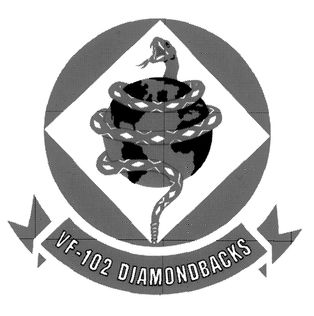
Captain John D. “Boomer” Stufflebeem, the CO of Carrier Air Wing One (CVW-i). He is shown here in his Pentagon office following the 1997/98 cruise. There he works as an executive assistant to Admiral Jay Johnson, the CNO.
JOHN D. GRESHAM
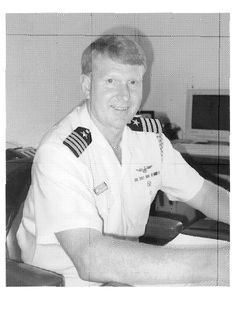
As squadrons are shuffled, merged, disbanded, or re-equipped, the makeup of an air wing may change, but the grouping of squadrons tends to be fairly stable over a period of years. The actual wing staff is quite small, just a few dozen officers and enlisted personnel. Because it is a “downsized” post-Cold War air wing, CVW-1 has given up one squadron of F-14’s as well as the A-6/KA-6 Intruder squadron, and picked up a third F/A-18 Hornet strike fighter squadron in return. The CVW-1 squadron assignments looked like this in late 1997:
•
Fighter Squadron 102 (VF-102
—The
“Diamondbacks”)—
One of the old F-14 squadrons that survived the drawdown a few years back,
VF-102 is commanded by Commander Kurt Daill. Based at Naval Air Station (NAS) Oceana, Virginia, and flying F-14Bs (equipped with F-110 engines), the Diamondbacks began the 1997/98 cruise with several new capabilities. They were equipped with the new AAQ-14 LANTIRN/GPS targeting pod, the improved Digital TARPS pod, and the GBU-24 Paveway III laser-guided bomb with BLU-109 penetrator warhead. These new systems make the Tomcat a powerful day and night strike fighter, as well as a potent reconnaissance platform. VF-102 operates fourteen F-14Bs, of which four are wired for the new D/TARPS pod. The squadron is also assigned six of the LANTIRN/GPS targeting pods. Of course, the Diamondbacks are still highly capable fighters, deploying the AIM-9M Sidewinder, AIM-7M Sparrow, and AIM-54C Phoenix air-to-air missiles (AAMs).
Fighter Squadron 102 (VF-102
—The
“Diamondbacks”)—
One of the old F-14 squadrons that survived the drawdown a few years back,
an “Air Group” instead of an Air Wing, thus the term “Commander, Air Group.” For most naval aviators, the honor of being addressed as “CAG” by the officers and enlisted men of their wing is considered to be one of the greatest achievements of their careers.
CVW-1 has three squadrons of Navy and Marine F/A-18C Hornet strike fighters. Each squadron can conduct strike or fighter missions, dropping Paveway II/III LGBs and other PGMs, firing AGM-88 HARM missiles, as well as AIM-9M and AIM-120 AMRAAM AAMs. Normally, each squadron of twelve aircraft deploys with six Nighthawk FLIR/laser targeting pods and three data-link pods for AGM-84E SLAM missiles. However, there are minor differences in the three units, which I’ll describe below:
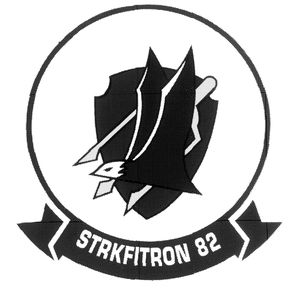
The official emblem of Strike Fighter Squadron 82 (VFA-82), the “Marauders.”
JACK RYAN ENTERPRISES, LTD., BY LAURA DENINNO
•
Strike Fighter Squadron 82 (VFA-82—the “Marauders
”)—Based at NAS Cecil Field, Florida and led by Commander Steven Callahan, the Marauders fly the new Block 18 version of the F/A-18C, with sharper eyes in the form of the new APG-73 radar. This is the radar that will go into the nose of the F/A-18E/F Super Hornet when it comes into service. The APG-73 will finally give the Navy the ability to perform high-resolution ground mapping in any weather, as well as non-cooperative target recognition (NCTR) against enemy aircraft.
Strike Fighter Squadron 82 (VFA-82—the “Marauders
”)—Based at NAS Cecil Field, Florida and led by Commander Steven Callahan, the Marauders fly the new Block 18 version of the F/A-18C, with sharper eyes in the form of the new APG-73 radar. This is the radar that will go into the nose of the F/A-18E/F Super Hornet when it comes into service. The APG-73 will finally give the Navy the ability to perform high-resolution ground mapping in any weather, as well as non-cooperative target recognition (NCTR) against enemy aircraft.
The official emblem of Strike Fighter Squadron 86 (VFA-86), the “Sidewinders.”
JACK RYAN ENTERPRISES, LTD., BY LAURA DENINNO
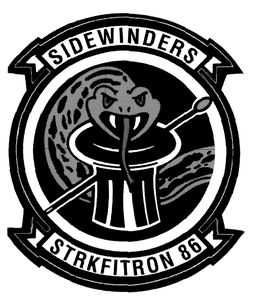
•
Strike Fighter Squadron 86 (VFA-86—the “Sidewinders”)—
Also based at NAS Cecil Field, Florida, VFA-86 has long been a sister squadron to VFA-82. VFA-86 flies the Block 10 version of the Hornet, and is commanded by Commander Robert Harrington.
Strike Fighter Squadron 86 (VFA-86—the “Sidewinders”)—
Also based at NAS Cecil Field, Florida, VFA-86 has long been a sister squadron to VFA-82. VFA-86 flies the Block 10 version of the Hornet, and is commanded by Commander Robert Harrington.
The official emblem of Marine Fighter Attack Squadron 251 (VMFA-251), the “Thunderbolts.”
JACK RYAN ENTERPRISES, LTD., BY LAURA DENINNO
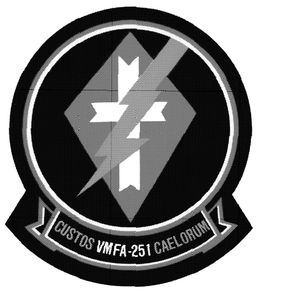
•
Marine Strike Fighter Squadron 251 (VFMA-251—the “Thunderbolts”)
—The Navy periodically requests the loan of Marine Corps carrier-capable strike-fighter and electronic-warfare squadrons to fill out air wings for deployment. Based out of MCAS Beaufort, South Carolina, the Thunderbolts fly the Block 16 version of the F/A-18C, and are commanded by Lieutenant Colonel Tony Valentino.
Marine Strike Fighter Squadron 251 (VFMA-251—the “Thunderbolts”)
—The Navy periodically requests the loan of Marine Corps carrier-capable strike-fighter and electronic-warfare squadrons to fill out air wings for deployment. Based out of MCAS Beaufort, South Carolina, the Thunderbolts fly the Block 16 version of the F/A-18C, and are commanded by Lieutenant Colonel Tony Valentino.
Other books
Uncle Dominic's Touch by Jenika Snow
Sabine by Moira Rogers
Live and Lime Die: A Key West Culinary Cozy - Book 8 by Summer Prescott
The Invasion Year by Dewey Lambdin
Kingdoms of the Wall by Robert Silverberg
The Witches' Book of the Dead by Christian Day
Genie Knows Best by Judi Fennell
Broken Souls by Beth Ashworth
Love Be Mine (The Louisiana Ladies Series, Book 3) by Busbee, Shirlee
For Frying Out Loud by Fay Jacobs